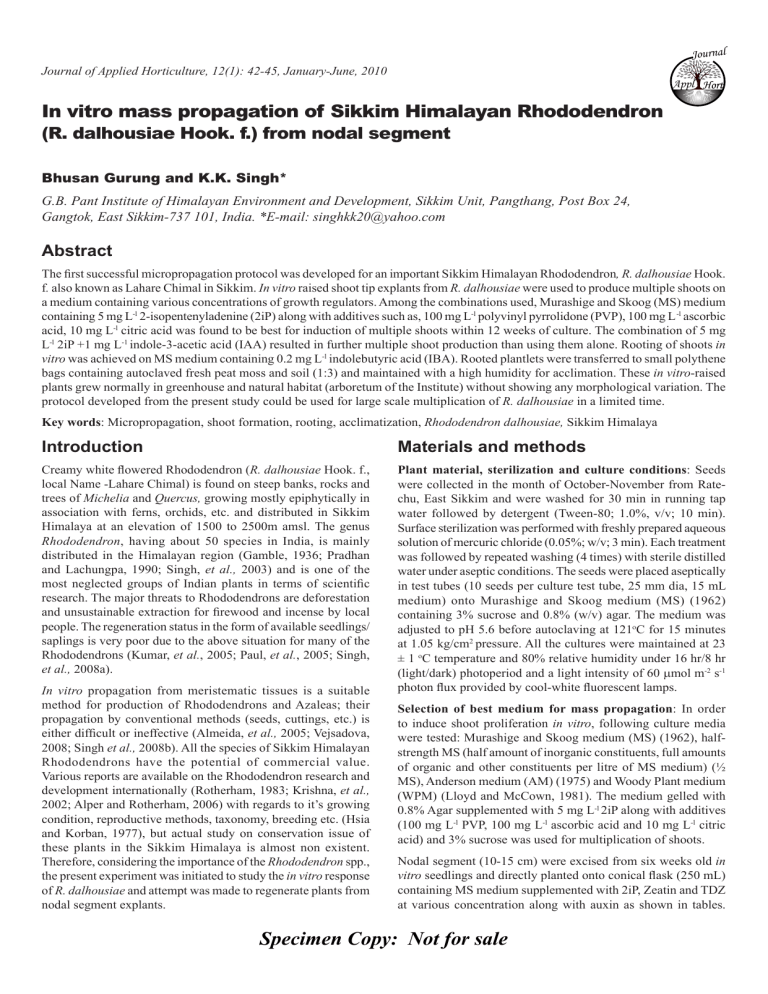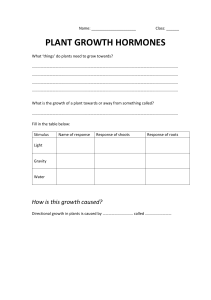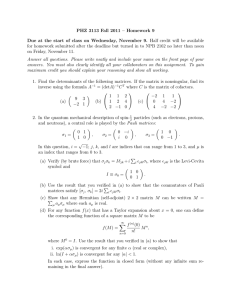
Journal Journal of Applied Horticulture, 12(1): 42-45, January-June, 2010 Appl In vitro mass propagation of Sikkim Himalayan Rhododendron (R. dalhousiae Hook. f.) from nodal segment Bhusan Gurung and K.K. Singh* G.B. Pant Institute of Himalayan Environment and Development, Sikkim Unit, Pangthang, Post Box 24, Gangtok, East Sikkim-737 101, India. *E-mail: singhkk20@yahoo.com Abstract The first successful micropropagation protocol was developed for an important Sikkim Himalayan Rhododendron, R. dalhousiae Hook. f. also known as Lahare Chimal in Sikkim. In vitro raised shoot tip explants from R. dalhousiae were used to produce multiple shoots on a medium containing various concentrations of growth regulators. Among the combinations used, Murashige and Skoog (MS) medium containing 5 mg L-l 2-isopentenyladenine (2iP) along with additives such as, 100 mg L-l polyvinyl pyrrolidone (PVP), 100 mg L -l ascorbic acid, 10 mg L-l citric acid was found to be best for induction of multiple shoots within 12 weeks of culture. The combination of 5 mg L-l 2iP +1 mg L-1 indole-3-acetic acid (IAA) resulted in further multiple shoot production than using them alone. Rooting of shoots in vitro was achieved on MS medium containing 0.2 mg L-l indolebutyric acid (IBA). Rooted plantlets were transferred to small polythene bags containing autoclaved fresh peat moss and soil (1:3) and maintained with a high humidity for acclimation. These in vitro-raised plants grew normally in greenhouse and natural habitat (arboretum of the Institute) without showing any morphological variation. The protocol developed from the present study could be used for large scale multiplication of R. dalhousiae in a limited time. Key words: Micropropagation, shoot formation, rooting, acclimatization, Rhododendron dalhousiae, Sikkim Himalaya Introduction Materials and methods Creamy white flowered Rhododendron (R. dalhousiae Hook. f., local Name -Lahare Chimal) is found on steep banks, rocks and trees of Michelia and Quercus, growing mostly epiphytically in association with ferns, orchids, etc. and distributed in Sikkim Himalaya at an elevation of 1500 to 2500m amsl. The genus Rhododendron, having about 50 species in India, is mainly distributed in the Himalayan region (Gamble, 1936; Pradhan and Lachungpa, 1990; Singh, et al., 2003) and is one of the most neglected groups of Indian plants in terms of scientific research. The major threats to Rhododendrons are deforestation and unsustainable extraction for firewood and incense by local people. The regeneration status in the form of available seedlings/ saplings is very poor due to the above situation for many of the Rhododendrons (Kumar, et al., 2005; Paul, et al., 2005; Singh, et al., 2008a). Plant material, sterilization and culture conditions: Seeds were collected in the month of October-November from Ratechu, East Sikkim and were washed for 30 min in running tap water followed by detergent (Tween-80; 1.0%, v/v; 10 min). Surface sterilization was performed with freshly prepared aqueous solution of mercuric chloride (0.05%; w/v; 3 min). Each treatment was followed by repeated washing (4 times) with sterile distilled water under aseptic conditions. The seeds were placed aseptically in test tubes (10 seeds per culture test tube, 25 mm dia, 15 mL medium) onto Murashige and Skoog medium (MS) (1962) containing 3% sucrose and 0.8% (w/v) agar. The medium was adjusted to pH 5.6 before autoclaving at 121oC for 15 minutes at 1.05 kg/cm2 pressure. All the cultures were maintained at 23 ± 1 oC temperature and 80% relative humidity under 16 hr/8 hr (light/dark) photoperiod and a light intensity of 60 μmol m-2 s-1 photon flux provided by cool-white fluorescent lamps. In vitro propagation from meristematic tissues is a suitable method for production of Rhododendrons and Azaleas; their propagation by conventional methods (seeds, cuttings, etc.) is either difficult or ineffective (Almeida, et al., 2005; Vejsadova, 2008; Singh et al., 2008b). All the species of Sikkim Himalayan Rhododendrons have the potential of commercial value. Various reports are available on the Rhododendron research and development internationally (Rotherham, 1983; Krishna, et al., 2002; Alper and Rotherham, 2006) with regards to it’s growing condition, reproductive methods, taxonomy, breeding etc. (Hsia and Korban, 1977), but actual study on conservation issue of these plants in the Sikkim Himalaya is almost non existent. Therefore, considering the importance of the Rhododendron spp., the present experiment was initiated to study the in vitro response of R. dalhousiae and attempt was made to regenerate plants from nodal segment explants. Selection of best medium for mass propagation: In order to induce shoot proliferation in vitro, following culture media were tested: Murashige and Skoog medium (MS) (1962), halfstrength MS (half amount of inorganic constituents, full amounts of organic and other constituents per litre of MS medium) (½ MS), Anderson medium (AM) (1975) and Woody Plant medium (WPM) (Lloyd and McCown, 1981). The medium gelled with 0.8% Agar supplemented with 5 mg L-l 2iP along with additives (100 mg L-l PVP, 100 mg L-l ascorbic acid and 10 mg L-l citric acid) and 3% sucrose was used for multiplication of shoots. Nodal segment (10-15 cm) were excised from six weeks old in vitro seedlings and directly planted onto conical flask (250 mL) containing MS medium supplemented with 2iP, Zeatin and TDZ at various concentration along with auxin as shown in tables. Specimen Copy: Not for sale In vitro mass propagation of Sikkim Himalayan Rhododendron (R. dalhousiae Hook. f.) from nodal segment MS medium lacking growth regulators served as control. After 12 weeks of culture, percentage of initiating shoots, average number of shoots and the average length of shoots per explant was recorded. All plant growth regulators (PGRs) used were from Sigma Chem. Company, USA. In vitro rooting and acclimatization: Well developed shoots obtained from MS medium fortified with 5 mg L-l 2iP and 1 mg L-l IAA were transferred to MS-liquid nutrient medium containing different concentrations of IBA, NAA and IAA on filter paper bridge. After 9 weeks of culture, percentage of rooted shoots, mean number of roots per shoot and root length were recorded. Rooted plants were washed with sterile distilled water then dipped in systemic fungicides (Bavestin, 0.15% , w/v; 20 min) and then planted in plastic pots (125 mL) containing autoclaved fresh peat moss and soil (1:3). The plants were hardened under high relative humidity (80%) in the mist chamber of greenhouse (25°C) of the Institute at the Pangthang, East Sikkim (Longitude 27o4’46” to 28o7’48” North, and Latitude 88o55’ to 88o55’25” East with an elevation 2087 m amsl). Well developed surviving plants were transferred to pots containing normal garden soil and maintained in greenhouse. Later, the plants were established in the field site (arboretum of the Institute). Statistical analysis: In all experiments, each treatment consisted of 20 replicates and each experiment was repeated twice. Standard error of the mean was calculated. Least significance difference (LSD) at P<0.05 level was calculated following the method of Snedecor and Cochran (1967). Results and discussion R. dalhousiae seeds germinated within 15-20 days of inoculation on hormone-free MS medium. On MS medium containing 3% sucrose and 0.8% (w/v) agar, germination was first recorded on 43 the 15th day of inoculation and after 30 days of inoculation an average germination of 67% was observed (Fig. 1A). The nodal segments that were obtained after six weeks old aseptic seedlings were used as the source of explants for the multiple shoot induction. The response of multiple shoots cultured on various media type, i.e., MS, ½, MS, AM and WPM, each supplemented with 5 mg L-l 2iP was compared. Of the four different medium tested, the frequency of multiple shoot was highest (71%) on MS medium and the lowest (18%) on WPM (Table 1). Thus MS medium was the best basal media among the four media attempted. Later, it was selected for supplementing various plant growth regulators for promoting shoot growth. Nodal segments cultured on different medium without any growth regulator did not show any response. Nodal segment (1.0-1.5 cm in length) were placed onto MS medium containing various concentrations of 2iP, Zeatin and TDZ. The explants cultured on MS basal medium without growth regulators failed to produce shoots even after 6 weeks of culture. While comparing the effect of cytokinin type (2iP, Zeatin and TDZ) on shoot formation, the best response was achieved in MS medium supplemented with 2iP (Fig. 1B). It was found that mean number of shoots per explant was highest on media containing 2iP, and increased as the concentration of 2iP increased from 1 to 5 mg L-l. Maximum percent of multiple shoots (68 %) and maximum mean number of shoots (9.0 ±0.6) were recorded at 5 mg L-l 2ip after 12 weeks of culture (Table 2). Kumar et al. (2004) had also observed that 2iP was effective for shoot multiplication of R. maddeni. In the MS medium, the number of shoots induced from each nodal segment increased till 5 mg L-l 2iP and decreased thereafter (Table 2). It was observed that the type and concentration of the cytokinin had a significant effect on the frequency of shoot regeneration, shoot number and shoot length as also seen in R. maddeni (Kumar et al., 2004). When higher Fig. 1. In vitro propagation of R. dalhousiae. (A) Germinating seeds in MS medium. (B) Multiplication of shoots on MS medium with 2iP (5 mg L-l). (C) Established shoots derived from nodal segment grown on MS medium supplemented with 2iP (5 mg L-l) and IAA (1 mg L-l). (D) Rooted microshoots. (E) Hardened in vitro raised plants after transfer to fresh peat moss and soil in green house. (F) Hardened plants in the greenhouse. Specimen Copy: Not for sale 44 In vitro mass propagation of Sikkim Himalayan Rhododendron (R. dalhousiae Hook. f.) from nodal segment Table 1. Effects of different media/substrates supplemented with 5 mg L-l 2iP on shoot proliferation from nodal explant of R. dalhousiae Media/ substrate Percent of explant producing shoots 71 ± 2.0 Mean number of shoots/ explant 8.0 ± 0.6 Mean shoot length (cm) 2.4 ± 0.2 ½ MS 31 ± 2.0 3.3 ± 0.3 1.47 ± 0.2 AM 65 ± 2.2 6.3 ± 0.9 2.16 ± 0.2 WPM 18 ± 2.0 2.0 ± 0.6 0.73 ± 0.7 12.7 2.11 0.23 MS LSD (P=0.05) Nodal segments cultured on different medium without growth regulators did not show any response. Values represent means ± standard error. Each treatment consisted of 20 replicates and the experiment was repeated twice. Data were recorded 12 weeks after transfer to culture medium. Table 2. Effects of plant growth regulators on induction of multiple shoots from nodal explant of R. dalhousiae on MS medium Mean Mean Concentration Percent of explant number shoot (mg L-l) producing of shoots/ length shoots explant (cm) Control 0 0 0 0 2iP 1 37 ± 2.7 2.3 ± 0.7 0.6 ± 0.1 3 58 ± 3.2 6.3 ± 0.3 1.0 ± 0.1 5 68 ± 3.1 9.0 ± 0.6 3.4 ± 0.2 7 63 ± 2.9 7.7± 0.3 1.8 ± 0.1 9 53 ± 4.1 4.7 ± 1.2 0.8 ± 0.2 Zeatin 1 8 ± 1.2 3.0 ± 0.6 0.9 ± 0.1 1.5 16 ± 1.2 4.7 ± 1.2 0.9 ± 0.1 3 20 ± 0.9 4.0 ± 1.2 0.8 ± 0.1 4 16 ± 0.6 4.0 ± 1.2 0.6 ± 0.1 5 11 ± 1.8 3.3 ± 1.5 0.5 ± 0.6 TDZ 1 13 ± 2.4 2.0 ± 0.6 0.6 ± 0.1 1.5 22 ± 1.7 4.7 ± 0.58 0.7 ± 0.1 3 28 ± 1.2 3.7 ± 0.3 0.7 ± 0.1 4 15 ± 2.3 4.0 ± 0.6 0.7 ± 0.1 5 13 ± 2.5 3.3 ± 0.6 0.6 ± 0.1 LSD (P=0.05) 13.38 2.85 0.45 Nodal segments cultured on MS medium without growth regulators did not show any response. Values represent means ± standard error. Each treatment consisted of 20 replicates and the experiment was repeated twice. Data were recorded 12 weeks after transfer to MS medium. Plant growth regulators concentration of TDZ was used, the number of shoots decreased or the treatment was less effective in inducing multiple shoots. Zeatin was found to be the least effective of all cytokinins used (Table 2) although TDZ and Zeatin have been successfully used during shoot proliferation of several Rhododendron species and hybrids (Fordham et al., 1982; Mertens et al., 1996; Almeida et al., 2005). Presence of IAA in medium also proved to be beneficial for shoot elongation. Of all the treatments used individually or in combination, a medium supplemented with 5 mg L-l 2iP + 1 mg L-l IAA induced highest numbers of multiple shoots per explant (10.7 ± 0.6) (Table 3, Fig. 1C). Regenerated shoots were subcultured every three weeks onto the freshly prepared same medium that was subjected to produce the highest proportional shooting response. Highest number of shoot regeneration was recorded at fourth subculture. The superiority of 2iP over all growth regulators for multiple shoot induction has been reported in many rhododendron species (Meyer, 1982; Anderson, 1984; Douglas, 1984) and related species such as azalea (Fordham et al., 1982). In vitro grown individual shoots were separated from the shoots of the primary culture and placed in MS-liquid medium containing different concentrations of auxins (NAA, IAA and IBA). Rooting was induced within 3 weeks of transfer. In the presence of auxins, the shoots produced root in all three concentrations, but IBA was found more suitable for root induction than IAA and NAA. A maximum frequency of root formation (86%) and the highest number of roots (5.3 ±0.9) with maximum root length (1.6 ±0.2 cm) was achieved on MS medium with 0.2 mg L-l IBA after 9 weeks (Table 4, Fig. 1D). At higher concentration (0.5 mg L-l IBA), a small amount of callus formed at the base. According to Ludvig-Muller (2000) transport velocity of IBA was markedly slower as compared to other growth regulators. Higher concentration of auxin lowered the rooting percentage as well as root number. Control shoots that did not receive auxin treatment did not root. Similar observations were made in other plants (Anderson, 1978; Wong, 1981; Kumar et al., 2004; Singh, 2008). Plantlets with fully expanded leaves and well developed roots were washed with sterile distilled water then dipped with systemic fungicides (Bavistin, 0.15%, w/v; 20 min) and planted in plastic pots (125 mL) containing autoclaved fresh peat moss and soil (1:3) (Fig. 1E). After two months these were planted in polythene bag containing normal garden soil, and placed for hardening under high relative humidity (80%) in the mist chamber of a greenhouse (Fig. 1F). After 180 days of transplantation 93% of the plants were found to survive with progressive growth in the field site. The in vitro regeneration of shoots, rooting and soil establishment protocol in this study suggests that there is possibility of adapting tissue culture technique for mass propagation of R. dalhousiae. Table 3. Effects of cytokinin combined with IAA on shoots proliferation from nodal explant of R. dalhousiae on MS medium Plant growth regulators (mg L-l) Percent of explants producing shoots Mean number of shoots/ explant Shoots length (cm) Nature of shoots 2iP IAA 3 - 54.3 ± 2.2 6.3 ± 0.9 0.7 ± 0.1 Yellow, defoliated 3 1.0 55.0 ± 1.8 6.7 ± 0.7 1.2 ± 1.8 Greenish yellow, defoliated 5 - 66.0 ± 3.1 8.7 ±0.9 2.8 ± 0.48 Greenish branched 5 1.0 70.0 ± 1.2 10.7 ± 0.6 3.6 ± 0.2 7 - 57.7 ± 1.5 8.3 ± 1.2 1.7 ± 0.3 7 1.0 56.3 ± 1.2 8.3 ±3.5 2.1 ± 0.4 11.38 3.84 0.84 LSD (P=0.05) Green healthy, branched Greenish yellow, clusters Green healthy, clusters Values represent means ± standard error. Each treatment consisted of 20 replicates and the experiment was repeated twice. Data were recorded 12 weeks after transfer to MS medium. Specimen Copy: Not for sale In vitro mass propagation of Sikkim Himalayan Rhododendron (R. dalhousiae Hook. f.) from nodal segment Table 4. Effect of different auxins incorporated in MS medium on rooting of the shoots of R. dalhousiae Rooting Mean number of Mean root Auxins frequency (%) roots per shoot length (cm) (mg L-l) IBA 0.1 24 4.0 ± 0.7 1.2 ± 0.1 0.2 86 5.3 ± 0.9 1.6 ± 0.2 0.3 58 3.3 ± 0.3 1.2 ± 0.1 0.5 56 2.7 ± 1.2 1.3 ± 0.1 IAA 0.1 27 3.3 ± 1.5 1.2 ± 0.2 0.2 39 3.7 ± 1.3 1.4 ± 0.2 0.3 26 3.0 ± 1.5 1.1 ± 0.1 0.5 20 3.3 ± 1.3 1.0 ± 0.1 NAA 0.1 26 3.7 ± 0.7 1.1 ± 0.1 0.2 45 5.0 ± 0.6 1.2 ± 0.2 0.3 56 4.3 ± 1.2 1.2 ± 0.1 0.5 28 3.3 ± 0.3 1.2 ± 0.1 17 1.4 0.98 LSD (P=0.01) Values represent means ± standard error. Each treatment consisted of 20 replicates and the experiment was repeated twice. Data were recorded 9 weeks after transfer to liquid-MS medium. This is the first report for in vitro regeneration of R. dalhousiae where large number of plant have been successfully produced and transferred to the field. Acknowledgements Authors are highly grateful to Dr. L.M.S. Palni, Director, G.B. Pant Institute of Himalayan Environment and Development, Almora, for all kinds of laboratory and institutional facilities. Miss Shanty Rai and Mr. Mohan Thapa are thanked for their assistance. References Almeida, R., S. Gonçalves and A. Romano, 2005. In vitro micropropagation of endangered Rhododendron ponticum L. subsp. baeticum (Boissier & Reuter) Handel-Mazzetti. Biodiversity and Conservation, 14: 1059-1069. Alper, H.C. and I.D. Rotherham, 2006. A review of the forest vegetation of turkey: Its status past and present and its future conservation. Biology and Environment Proceeding Royal Iris Academy, 106B, 343-354. Anderson, W.C. 1975. Propagation of rhododendrons by tissue culture. Part 1. Development of a culture medium for multiplication of shoots. Proceedings Plant Propagators Society, 25: 129-135. Anderson, W.C. 1978. Rooting of tissue-cultured rhododendrons. Proceedings Plant Propagators Society, 28: 135-139. Anderson, W.C. 1984. A revised tissue culture medium for shoot multiplication of rhododendron. Journal American Society Horticultural Science, 109: 343-347. Douglas, G.C. 1984. Propagation of eight cultivars of rhododendron in vitro using agar-solidified media and direct rooting of shoots in vivo. Scientia Horticulturae, 24, 337-347. Fordham, I., D.P. Stimart and R.H. Zimmerman, 1982. Axillary and adventitious shoot proliferation of Exbury Azaleas in vitro. Horticulture Science, 17: 738-139. Gamble, J. 1936. A Manual of Indian Timbers. Sampson Low, Marston & Co., London. 45 Hsia, C.N. and S.S. Korban, 1977. The influence of cytokinins and ionic strength of Anderson’s medium on shoot establishment and proliferation of evergreen azalea. Euphytica, 93: 11-17. Krishna, A.P., S. Chhetri and K.K. Singh, 2002. Human dimensions of conservation in the Kangchenzonga Biosphere Reserve: The need for conflict prevention. Mountain Research Development, 22: 328-331. Kumar, S., L.K. Rai, K.K. Singh and U. Bajpai, 2005. Spermoderm pattern in seeds of rhododendron in Sikkim Himalaya, India-1. SEM Studies. Phytomorphology, 55: 01-08. Kumar, S., K.K. Singh and L.K. Rai, 2004. In vitro propagation of an endangered Sikkim Himalayan Rhododendron (R. maddeni) from cotyledonary nodal segments. Journal American Rhododendrons Society, 58: 101-105. Lloyd, G. and B. McCown, 1981. Commercially-feasible micropropagation of mountain laurel, Kalmia Latifolia, by use of shoot tips culture. Combined Proceedings International Plant Propagators Society, 30: 421-427. Ludvig-Muller, J. 2000. Indole-3-butyric acid in plant growth and development. Plant Growth Regulators, 32: 219-230. Mertens, M., S. Werbrouck, G. Samyn, H. Botelho dos Santos Moreira da Silva and P. Deberg, 1996. In vitro regeneration of evergreen azalea from leaves. Plant Cell, Tissue Organ Culture, 45: 231-236. Meyer, M.M. 1982. In vitro propagation of rhododendron catawbiense from flower buds. Horticulture Science, 17: 891-892. Murashige, T. and F. Skoog, 1962. A revised medium for rapid growth and bioassays with tobacco tissue cultures. Physiologia Plantarum, 15: 473-497. Paul, A., M.L. Khan, A. Arunachalam and K. Arunachalam, 2005. Biodiversity and conservation of rhododendrons in Arunachal Pradesh in the Indo-Burma biodiversity hot spot. Current Science, 89: 623-634. Pradhan, U.C. and S.T. Lachungpa, 1990. Sikkim-Himalayan Rhododendrons. Primulaceae Books, Kalimpong, West Bengal, India. Rotherham, I. D. 1983. The ecology of Rhododendron ponticum L. with special reference to its competitive and invasive capabilities. Ph.D. thesis, University of Scheffield, UK. Singh, K.K. 2008. In vitro plant regeneration of an endangered Sikkim Himalayan Rhododendron (R. maddeni Hook. f.) from Alginateencapsulated shoot tips. Biotechnology, 7: 144-148. Singh, K.K., S. Kumar and A. Pandey, 2008a. Soil treatments for improving seed germination of rare and endangered Sikkim Himalayan Rhododendrons. World Journal Agricultural Sciences, 4(2): 288-296. Singh, K.K., S. Kumar, L.K. Rai and A.P. Krishna, 2003. Rhododendron conservation in Sikkim Himalaya. Current Science, 85: 602-606. Singh, K.K., S. Kumar and R. Shanti, 2008. Raising planting materials of Sikkim Himalayan Rhododendron through vegetative propagation using “Air-wet technique”. JournalAmerican Rhododendron Society, 62: 136-138. Snedecor, G.W. and W.G. Cochran, 1967. Statistical Methods. Oxford and IBH publishing Co., New Delhi. pp. 593. Vejsadová, H. 2008. Growth regulator effect on in vitro regeneration of rhododendron cultivars. Horticultural Science (Prague), 35(2): 90-94. Wong, S. 1981. Direct rooting of tissue-cultured rhododendrons into an artificial soil mix. Proceedings Plant Propagators Society, 31: 36-39. Specimen Copy: Not for sale


